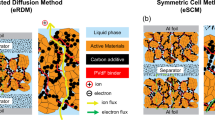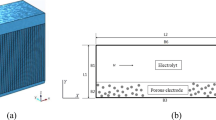Abstract
The aim of this investigation is to define a model of an alternating current impedance response that can identify the state of health of a porous electrode due to the blocked diffusion effect. To identify and simulate different pore geometries, an analytical differential equations system was studied. Standard and low performance battery products were simulated by the model and validated with electrochemical impedance spectroscopy (EIS) experimental data. The correlation between pore structure geometries and the related battery efficiency is also addressed. This investigation may clarify the possible reasons for low performance batteries. Identifying the benchmark pore geometry, parameters may be useful for the battery producers to improve the efficiency of their products. Various recovery methods are also included in this investigation to disperse the build-up of lead sulphate crystal that limits the electrolysis process in the low performance batteries.
Similar content being viewed by others
References
N. E. Bagshaw. Improving active-material utilization. Journal of Power Sources, vol. 67, no. 1–2, pp. 105–109, 1997.
R. D. Prengaman. Improvements to active material for VRLA batteries. Journal of Power Sources, vol. 144, no. 2, pp. 426–437, 2005.
R. Ponraj, S. D. McAllister, I. F. Cheng, D. B. Edwards. Investigation on electronically conductive additives to improve positive active material utilization in lead-acid batteries. Journal of Power Sources, vol. 189, no. 2, pp. 1199–1203, 2009.
X. S. Lang, D. L. Wang, C. Y. Hu, S. Z. Tang, J. S. Zhu, C. F. Guo. The use of nanometer tetrabasic lead sulfate as positive active material additive for valve regulated leadacid battery. Journal of Power Sources, vol. 270, pp. 9–13, 2014.
R. De Marco, A. Lowe, M. Sercombe, P. Singh. An electrochemical impedance spectroscopy and scanning electron microscopy study of the influence of positive plate compression on the electrochemical behaviour of lead-acid batteries. Electrochimica Acta, vol. 51, no. 10, pp. 2088–2095, 2006.
D. N. Winslow. Advances in experimental techniques for mercury intrusion porosimetry. Surface and Colloid Science, vol. 13, pp. 259–282, 1984.
P. E. Dim, R. S. Fletcher, S. P. Rigby. Improving the accuracy of catalyst pore size distributions from mercury porosimetry using mercury thermoporometry. Chemical Engineering Science, vol. 140, pp. 291–298, 2016.
W. Li, Z. H. Chen. Pore geometry of 3D-Cf /SiC composites by mercury intrusion porosimetry. Ceramics International, vol. 35, no. 2, pp. 747–753, 2009.
A. Mariani, K. Thanapalan, J. Williams, P. Stevenson. Investigation of the influence of active material structure on high rate discharge performance of VRLA batteries. International Journal of Energy Science and Engineering, vol. 1, no. 3, pp. 115–125, 2015.
A. Mariani, K. Thanapalan, P. Stevenson, J. Williams. Techniques for estimating the VRLA batteries ageing, degradation and failure modes. In Proceedings of the 19th International Conference on Automation and Computing, IEEE, London, UK, pp. 43–47, 2013.
L. Holzer, D. Wiedenmann, B. Münch, L. Keller, M. Prestat, P. Gasser, I. Robertson, B. Grobéty. The influence of constrictivity on the effective transport properties of porous layers in electrolysis and fuel cells. Journal of Materials Science, vol. 48, no. 7, pp. 2934–2952, 2013.
A. Jena, K. Gupta. An innovative technique for pore structure analysis of fuel cell and battery components using flow porometry. Journal of Power Sources, vol. 96, no. 1, pp. 214–219, 2001.
R. De Levie. On the impedance of electrodes with rough interfaces. Journal of Electroanalytical Chemistry and Interfacial Electrochemistry, vol. 261, no. 1, pp. 1–9, 1989.
H. Keiser, K. D. Beccu, M. A. Gutjahr. Abschätzung der porenstruktur poröser elektroden aus impedanzmessungen. Electrochimica Acta, vol. 21, no. 8, pp. 539–543, 1976.
A. Mariani, K. Thanapalan, P. Stevenson, T. Stockley, J. Williams. Techniques for monitoring and predicting the OCV for VRLA battery systems. In Proceedings of the 21st International Conference on Automation and Computing, IEEE, Glasgow, UK, pp. 1–6, 2015.
C. Hitz, A. Lasia. Experimental study and modeling of impedance of the her on porous Ni electrodes. Journal of Electroanalytical Chemistry, vol. 500, no. 1–2, pp. 213–222, 2001.
K. Eloot, F Debuych, M. Moors, A. P. Van Peteghem. Calculation of the impedance of noncylindrical pores Part I: Introduction of a matrix calculation method. Journal of Applied Electrochemistry, vol. 25, no. 4, pp. 326–333, 1995.
Yuasa Battery (Europe) Ltd. Valve Regulated Lead- Acid Batteries SWL SERIES, [Online], Available: http://www.yuasaeurope.com, April 30, 2015.
N. A. Hampson, S. A. G. R. Karunathilaka, R. Leek. The impedance of electrical storage cells. Journal of Applied Electrochemistry, vol. 10, no. 1, pp. 3–11, 1980.
Y. Q. Lai, Y. Li, L. X. Jiang, W. Xu, X. J. Lv, J. Li, Y. X. Liu. Electrochemical behaviors of co-deposited Pb/Pb- MnO2 composite anode in sulfuric acid solution-Tafel and EIS investigations. Journal of Electroanalytical Chemistry, vol. 671, pp. 16–23, 2012.
P. Ruetschi. Silversilver sulfate reference electrodes for use in lead-acid batteries. Journal of Power Sources, vol. 116, no. 1–2, pp. 53–60, 2003.
K. L. Man, E. G. Lim, M. Leach, J. K. Lee, K. K. Kim. Simulation and analysis of desulfator for smart battery system. In Proceedings of 2014 International SoC Design Conference, IEEE, Jeju, South Korea, pp. 173–174, 2014.
L. T. Lam, H. Ozgun, O. V. Lim, J. A. Hamilton, L. H. Vu, D. G. Vella, D. A. J. Rand. Pulsed-current charging of lead/acid batteries-a possible means for overcoming premature capacity loss. Journal of Power Sources, vol. 53, no. 2, pp. 215–228, 1995.
D. Bernt. Valve-regulated lead-acid batteries. Journal of Power Sources, vol. 95, no. 1–2, pp. 2–12, 2001.
A. Kirchev, A. Delaille, M. Perrin, E. Lemaire, F. Mattera. Studies of the pulse charge of lead-acid batteries for PV applications: Part II. Impedance of the positive plate revisited. Journal of Power Sources, vol. 170, no. 2, pp. 495–512, 2007.
X. Muneret, V. Gobe and C. Lemoine. Influence of float and charge voltage adjustment on the service life of AGM VRLA batteries depending on the conditions of use. Journal of Power Sources, vol. 144, no. 2, pp. 322–328, 2005.
S. Piller, M. Perrin, A. Jossen. Methods for state-of-charge determination and their applications. Journal of Power Sources, vol. 96, no. 1, pp. 113–120, 2001.
V. Svoboda, H. Doering, J. Garche. The influence of fast charging on the performance of VRLA batteries. Journal of Power Sources, vol. 144, no. 1, pp. 244–254, 2005.
J. H. Yan, H. Y. Chen, W. S. Li, C. I. Wang, Q. Y. Zhan. A study on quick charging method for small VRLA batteries. Journal of Power Sources, vol. 158, no. 2, pp. 1047–1053, 2006.
Acknowledgement
The authors would also like to thank the staff of the Centre for Automotive and Power Systems Engineering (CAPSE) for their assistance. The first author would like to acknowledge the financial support from the Knowledge Economy Skills Scholarships (KESS), Yuasa Battery Ltd and the University of South Wales (USW) during this research project.
Author information
Authors and Affiliations
Corresponding author
Additional information
Recommended by Guest Editor Dongbing Gu
Alessandro Mariani received the B. Eng. degree from University of Glamorgan, UK in 2010. He is currently a Ph.D. degree candidate at University of South Wales, UK. He collaborated with Yuasa Ltd from 2011 to 2016 as researcher in optimization, simulation and fault analysis of electrochemical device design, including research, development and manufacture process alternative to optimize the storage device efficiency. He is a member of IET.
His research interests include lead acid battery technology and electrochemical performance analysis.
ORCID iD: 0000-0001-5810-2681
Kary Thanapalan received the B.Eng. degree in control engineering from City University London, UK. Later he received the Ph.D. degree in aerospace control systems from the University of Liverpool, UK, and then conducted his research and development activities in various capacities. He is currently working as a senior researcher in the faculty of computing, engineering and sciences, University of South Wales, UK, and a leading researcher in the fields of energy and renewable energy and control and automation engineering with a strong focus on mathematical modelling and control of energy storage systems. He has published over 50 research papers in peer reviewed international journals and refereed international conferences. He is a chartered engineer and a member of IET (CEng, MIET).
His research interests include control system design, renewable energy and optimization analysis.
ORCID iD: 0000-0001-6398-4340
Peter Stevenson received the M. Sc. degree in chemistry from the University of Cambridge, UK in 1979. He has worked on various research projects during his time at Yuasa Battery (Europe) Ltd as well as academia, he has broad experience in electrochemical device design, energy storage management lean manufacturing process development and standardisation. He has managed complete project from product concept design and development to production and resolving issues at each stage. He is currently working as senior technical co-ordinator at the Yuasa Battery (Europe) Ltd.
His research interests include lead acid and lithium battery technology.
ORCID iD: 0000-0003-3894-2207
Jonathan Williams received the M. Eng. degree in mechatronic engineering and has since worked with numerous industrial companies and specialist materials companies at the University of South Wales, UK, resulting in the development of new products, process and the investment of over 6.2 million pounds in associated research programme and facilities. He is currently working as a CAPSE director at the University of South Wales, UK, and a leading researcher in the development of new innovative energy storage system and solutions.
His research interests include power system engineering and lithium based energy storage.
Rights and permissions
About this article
Cite this article
Mariani, A., Thanapalan, K., Stevenson, P. et al. An advanced prediction mechanism to analyse pore geometry shapes and identification of blocking effect in VRLA battery system. Int. J. Autom. Comput. 14, 21–32 (2017). https://doi.org/10.1007/s11633-016-1040-0
Received:
Accepted:
Published:
Issue Date:
DOI: https://doi.org/10.1007/s11633-016-1040-0




